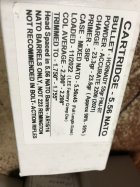Sierra publishes load data for .223 Rem, and separates it by bolt gun and AR-15 applications. In their .223 cartridge guide, AccurateShooter.com mentions the AR being more sensitive to pressure than a good bolt gun, and I've always assumed that to be the case.
Why would the max published bolt gun load for a given powder/bullet/primer/COL be lower (sometimes significantly so) than the same for an AR-15? This is Sierra's load data for their bullets and Hodgdon powder (I've got a bunch).
H335 looks like what I'd expect: a reduced load compared to the bolt gun load. Varget looks backwards on the lighter bullets, and H322 looks backwards all around (except if you look at the data for the 63gr SMP with H322, where the bolt gun load is slightly higher).
I'm not particularly concerned with the actual number on the published max loads (I'll work up the load from a safe starting point), but I'm curious about this pattern. Is there something about H322 (and maybe Varget) that would generally have you running a hotter load in an AR than in a bolt gun?
Why would the max published bolt gun load for a given powder/bullet/primer/COL be lower (sometimes significantly so) than the same for an AR-15? This is Sierra's load data for their bullets and Hodgdon powder (I've got a bunch).
Code:
components bolt max AR max diff
45gr / H322 25.3 25.7 -0.4
45gr / H335 28.3 27.7 +0.6
50gr / H322 24.9 25.2 -0.3
50gr / H335 28.0 26.4 +1.6
52gr / H322 24.3 25.2 -0.9
52gr / H335 27.6 26.7 +0.9
52gr / Varget 26.7 27.5 -0.7
55gr / H322 23.9 24.3 -0.4
55gr / H335 27.5 25.7 +1.8
55gr / Varget 26.9 27.2 -0.3
69gr / H335 25.7 23.8 +1.9
69gr / Varget 26.4 26.1 +0.3H335 looks like what I'd expect: a reduced load compared to the bolt gun load. Varget looks backwards on the lighter bullets, and H322 looks backwards all around (except if you look at the data for the 63gr SMP with H322, where the bolt gun load is slightly higher).
I'm not particularly concerned with the actual number on the published max loads (I'll work up the load from a safe starting point), but I'm curious about this pattern. Is there something about H322 (and maybe Varget) that would generally have you running a hotter load in an AR than in a bolt gun?















